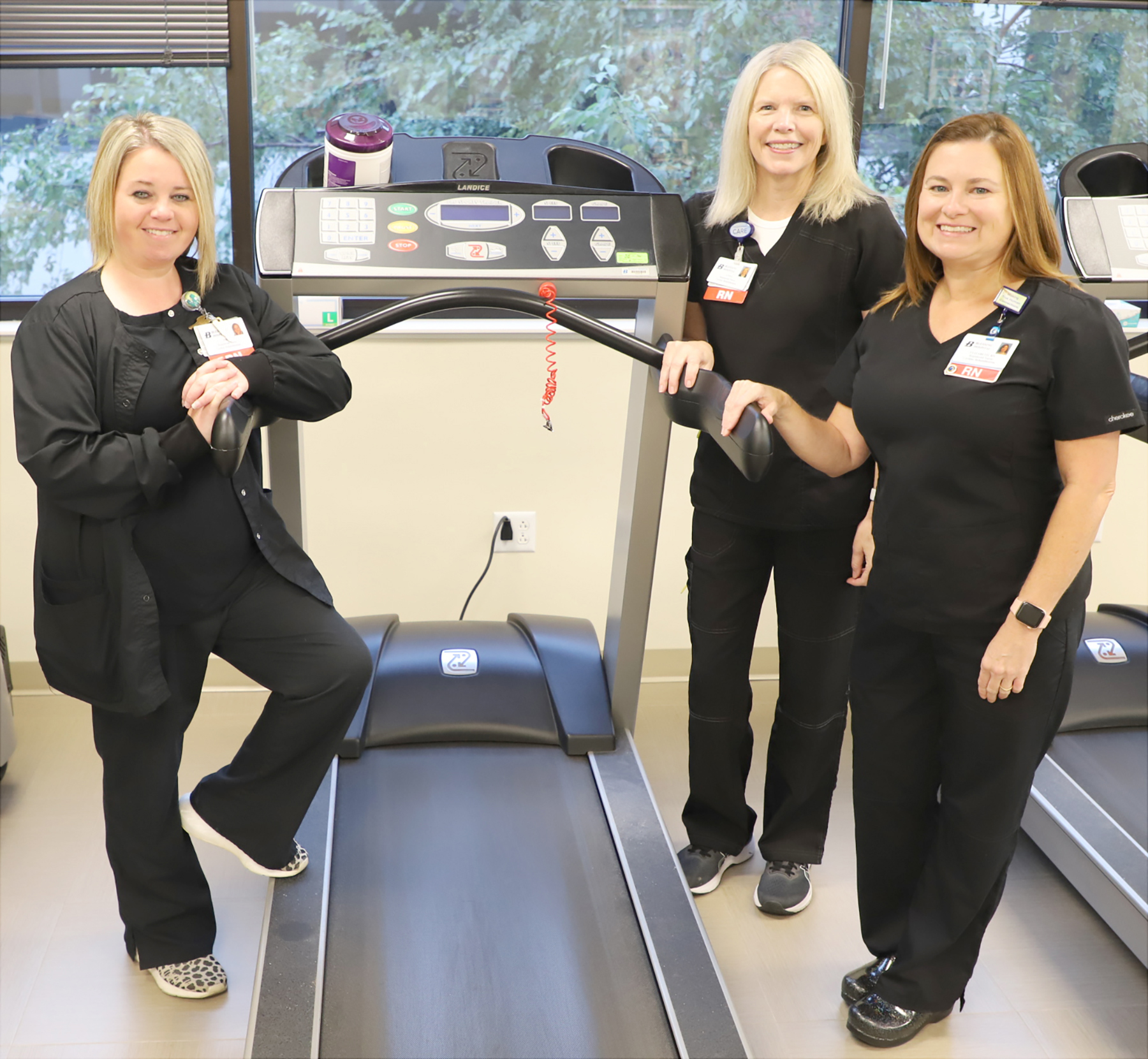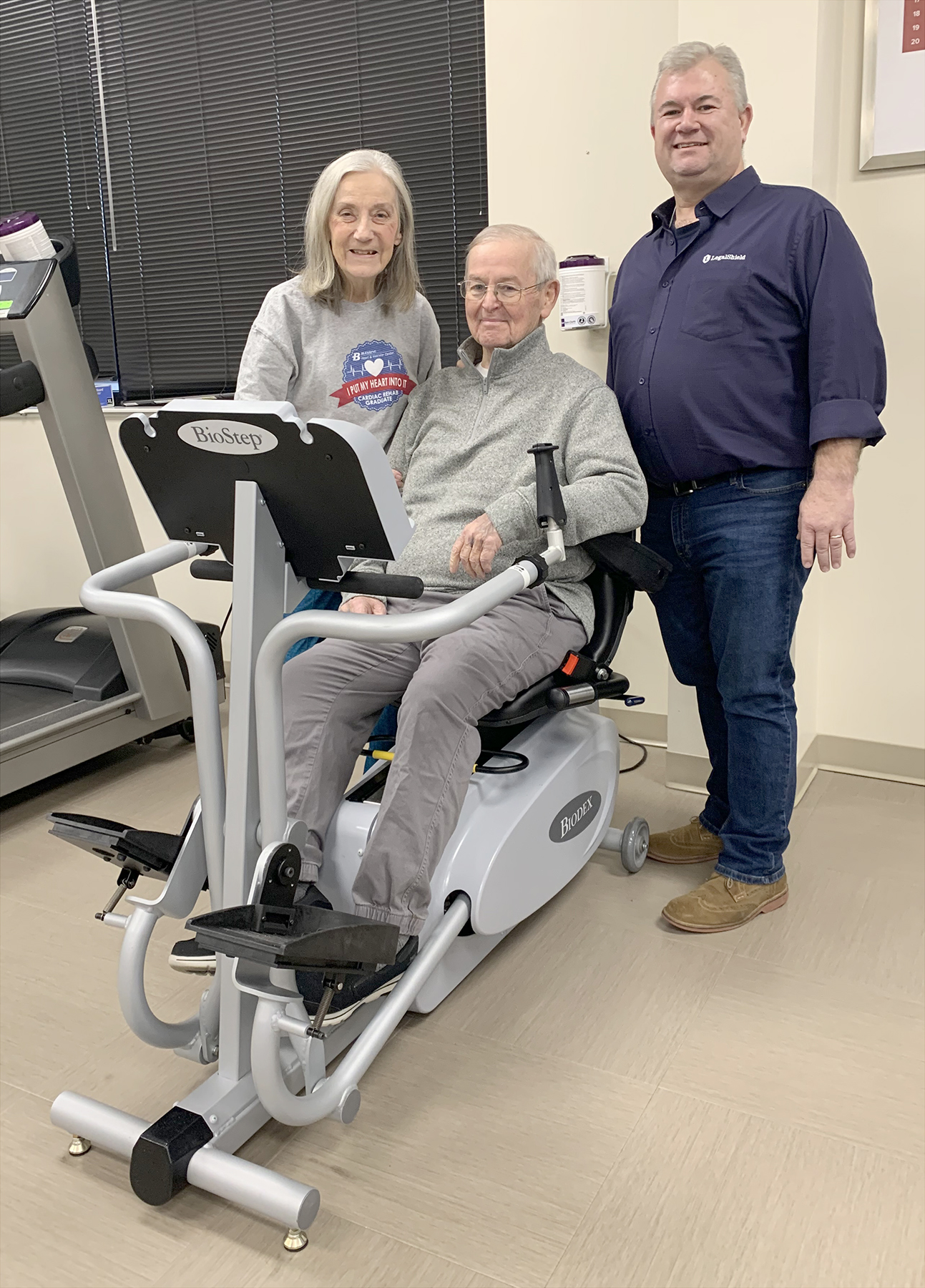
“Walking with a friend in the dark is better than walking alone in the light.” American author, disability rights advocate, political activist and lecturer Helen Adams Keller said that. Her insight describes the relationship between Joyce Hildebrand, Danny Vahlkamp and Rich Ellerman.
“They are delightful,” Joyce said of Rich and Danny. “I thought, if those guys can do it, I can do it.”
“I got to feeling better and in a little bit better shape, and met some really nice people along the way,” Danny added.
“There were days when none of us felt like being here,” Rich said. “Joyce and Danny would still work pretty hard. I would feed off that.”
These three very different people met during 2023 when they participated at the same time in Blessing Hospital’s nationally accredited cardiac rehabilitation program after surviving heart disease.
What is cardiac rehabilitation?
Blessing’s cardiac rehabilitation team works with a patient’s heart doctor to develop a health and wellness plan tailored to the patient’s specific needs and limitations. Studies show patients who participate in a cardiac rehabilitation program after a heart attack, heart failure or other heart problem that requires surgery or medical care, lessened their chances of another heart attack and decreased their chance of death related to their condition in the following five years by about 35%.
Participating in a cardiac rehabilitation program has also shown to lessen the physical and emotional effects of heart disease and improve a person’s confidence and well-being. Those who actively participated in a cardiac rehabilitation program reported improved stamina and strength, returning to their usual activities, including work, hobbies and regular exercise quicker than those who did not participate.
How does it work?
Patients attend cardiac rehabilitation for one hour, three times a week. They follow a structured physical fitness program that helps gradually build endurance and heart and lung function through the use of cardio machines such as treadmills and stationary bikes, in addition to strength-training exercises. Participants are monitored by cardiac rehabilitation nurses in the program’s gym.
“A heart condition is scary,” said Tori Davenport, RN, Blessing cardiac rehabilitation. “When patients come to see us in the outpatient gym after their heart event, they can be overwhelmed seeing the exercise equipment. It usually doesn’t take long for them to become comfortable with their exercise routine, knowing that they are monitored by cardiac nurses and alongside other patients who, oftentimes, become friends.”
In addition to exercise, cardiac rehabilitation offers wellness education focusing on a range of healthy-living topics including eating, weight loss, smoking cessation and stress management. When needed, the cardiac rehabilitation team will also work with the patient and their provider to maintain a healthier range for blood pressure, diabetes and cholesterol numbers.
Blessing Hospital’s cardiac rehabilitation program holds accreditation from the American Association of Cardiovascular and Pulmonary Rehabilitation (AACVPR).
Joyce’s story
Joyce Hildebrand is a retired Blessing Hospital nurse. One day, the 79-year-old was not feeling well. Her husband, Kenny, suggested a visit to the Blessing Hospital Emergency Center. Joyce agreed, but suddenly changed her mind.
“On the way I started to feel better,” she recalled. “I said to Kenny, ‘Let’s go back home.’ He said no.”
Kenny’s decision may have saved Joyce’s life. She underwent open heart surgery for a quadruple bypass to re-route the blood around blockages to her heart. At the suggestion of her surgeon, Joyce participated in Blessing’s cardiac rehabilitation program for three months.
“I wanted to make sure I recovered totally and was able to be myself again,” Joyce said about her decision to participate in cardiac rehabilitation.
In addition to strengthening her body after major surgery, the program boosted her spirit.
“The best thing it did is it gave me more self-confidence that I was going to be okay.”
Danny’s story
A 79-year-old Air Force veteran and retired electrician, Danny Vahlkamp enjoyed a piece of fried chicken late one night and soon began experiencing what he thought was indigestion. Thirteen hours later, after over-the-counter indigestion medicine did not help, Danny went to the Blessing Emergency Center.
“Indigestion medicine does not fix a heart attack. I found that out,” he said.
Danny left the hospital with six stents to improve the blood flow through his narrowing heart arteries and chose to participate in cardiac rehabilitation.
“I felt the program gave me a good basis to know what to do to try to get myself better. I was happy with what I did here.”
Today, Danny continues to exercise, using free weights and a recumbent bike his children bought him for Christmas.
Rich’s story
Rich Ellerman, a veteran of the Marine Corps and a self-employed entrepreneur, is the youngest of this trio of cardiac rehabilitation graduates.
During a routine visit to his primary care provider, Dr. Matthew Cormier of the Blessing Employer Clinic, Rich asked him about some mild, flu-like symptoms he had been feeling that would come and go. That conversation led to two tests – an electrocardiogram (EKG) and a stress test – and the diagnosis by Blessing Health cardiology of multiple heart blockages. Rich received four stents to improve blood flow.
In his years since leaving the Marines, Rich was busy building a career and not as physically active as he knew he should be.
“Cardiac rehab was a chance to be physically active again,” he said. “If I had not walked out of here feeling good about the progress that I made and the ability to continue what this program started in me, I probably would have returned to the same things I was doing,” he said. “Cardiac rehab gives a person the ability to redevelop good habits.”
Upon completing cardiac rehabilitation, Rich worked with a personal trainer to develop a long-term exercise program and works out three to five times a week.
“The program provides the opportunity to be self-accountable, to know that recovery is possible and that you don’t have to do it alone,” he concluded.
From the nurses’ point of view
Joyce, Danny and Rich had high praise for the nurses of Blessing’s cardiac rehabilitation program.
“They are motivating. They are the best,” Joyce said.
The nurses feel the same way about this trio, and all of their former patients.
“Cardiac rehab is definitely a team effort involving the patient, doctors, nurses and dietitians,” said Blessing cardiac rehabilitation nurse Linda Sperry, RN. “Joyce, Danny and Rich were also part of their own team. They were very supportive of each other and had a special bond. It was very rewarding coming to work and seeing them work together.”
“A lot of times health and mental hurdles come into play after a heart condition,” nurse Tori Davenport added. “Joyce, Danny and Rich were there to pick each other up. They used each other to lean on for good outcomes physically and mentally. They made big strides.”
Danny adds the following advice: “Make changes before it is too late.”
A doctor’s referral is required to participate in cardiac rehabilitation. For more information, go to blessinghealth.org/treatments/cardiac-rehab
